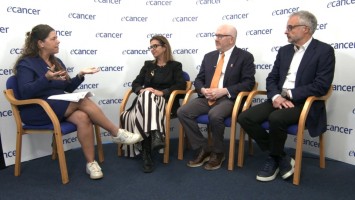I’m presenting a phase I study of a combination of telaglenastat, also known as CB-839, in combination with cabozantinib in metastatic renal cell carcinoma. This is a really interesting study because CB-839 is a first in human, first in class glutaminase inhibitor and we’ve already presented the phase I data with this agent. This is an agent that modulates glutamine metabolism and glutamine and glucose are the two key nutrients for cancer cells and renal cell carcinoma has high levels of glutaminase expression. In vitro renal cell carcinoma cell lines are quite responsive to inhibition with glutaminase inhibitor CB-839.
The thought is that by combining inhibition with cabozantinib, which in part also affects glucose metabolism by inhibiting that, and CB-839 by inhibiting glutamine metabolism there’s in vitro synergistic effect and in vivo they have demonstrated that there is enhanced efficacy of the combination. So that has led to the phase I trial being presented.
In this study we’ve done dose escalation looking at the approved doses of cabozantinib at 60mg and looking at CB-839 at two doses, at 600mg and 800mg, and looking at the safety, tolerability and pulmonary efficacy effects. We demonstrated that this combination is safely delivered. We had really an adverse event profile that was very similar to what we’ve seen with cabozantinib alone. The monotherapy recommended phase II dose for CB-839 is the same as what has been chosen for the recommended phase II dose for the combination and we did not have any dose limiting toxicity.
We had a promising efficacy signal. We enrolled a total of 13 patients that were evaluable for toxicity and 12 patients that were evaluable for efficacy data. Of the 12 patients we had an objective response rate of 42% overall. Of those 12 patients 10 had clear cell renal cell carcinoma and our objective response rate in that group was 50% and that looks very promising compared to cabozantinib monotherapy. Of course our studies are a limited number of patients.
At the time of our study data cut-off we still had 5 patients on study or had gotten treatment for 14 months or longer and 3 patients were still on treatment at data cut-off. Really we’ve seen deep responses in these patients that had been previously treated with multiple lines of therapy and, in fact, in the overall study group almost a third of the patients had at least two lines or more of anti-VEGF therapy.
So in a heavily pre-treated population this is a promising signal and now there is an ongoing randomised clinical trial with registration intent.








